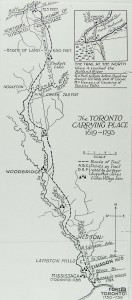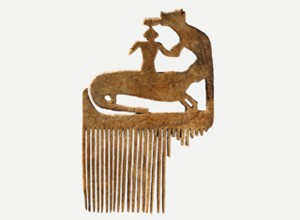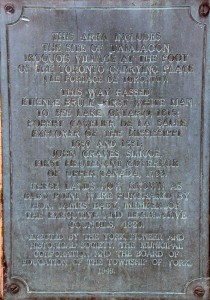THE ORIGINAL INHABITANTS: FIRST NATIONS PEOPLES
Teiaiagon: The neck of the peninsula of Baby Point is traversed by an ancient aboriginal trail, which dates back more than 4000 years and is the traditional territory of many first nations including the Mississaugas of the Credit, the Anishnabeg, the Chippewa, the Haudenosaunee and the Wendat peoples and is now home to many diverse First Nations, Inuit and Métis peoples. There are  Paleolithic camp sites all along the trail, one of which is just north of Baby Point on Langmuir (now Humbercrest Blvd) stretching north to St. Mark’s Road.This ancient lakeshore trail would have come north to the break in the ravine and a fording location at what is now the Old Mill Bridge crossing. The Baby Point height of land which overlooked this important crossing – intersecting with what became the Carrying Place Pathway— commanded sight lines of both routes, and was a natural fortification site. The Seneca village of Teiaiagon was strategically located at this site, the limits of navigable water when paddling north from the mouth of the Humber River.
Paleolithic camp sites all along the trail, one of which is just north of Baby Point on Langmuir (now Humbercrest Blvd) stretching north to St. Mark’s Road.This ancient lakeshore trail would have come north to the break in the ravine and a fording location at what is now the Old Mill Bridge crossing. The Baby Point height of land which overlooked this important crossing – intersecting with what became the Carrying Place Pathway— commanded sight lines of both routes, and was a natural fortification site. The Seneca village of Teiaiagon was strategically located at this site, the limits of navigable water when paddling north from the mouth of the Humber River.
Sometime after 1687, the Senecas disappeared from the Point, returning to the south shore of Lake Ontario. There are differing points of view as to why this happened: first, the French, heavily invested in the fur trade, burned Teiaiagon in 1687 to punish the Senecas for trading with the English and Dutch to the south; second, it was related to a threat or attack by Governor Denonville (who weathered out a storm by anchoring in the Humber Marshes in 1687 while returning from an attack on the Iroquois in Niagara); or, that the land was becoming depleted for agricultural purposes. (Image: Map of the Toronto Carrying Place)
By 1700, the Mississauga First Nation (Ojibway in origin) controlled the Baby Point area, hunting and trading here. Now known as the Mississaugas of the New Credit, they were the First Nation of the Toronto Purchase of 1787 and 1805. Toronto is covered by Treaty 13 signed with the Mississaugas of the Credit, and the Williams Treaties signed with multiple Mississaugas and Chippewa bands. The related land claims were settled at the end of May, 2010 by Treaty 13.
This historic plaque, mounted on a large granite boulder found at the corner of Baby Point Road and Baby Point Crescent, marks the Teiaiagon site. The plaque reads This area includes the site of Teiaiagon Iroquois Village at the foot of the Toronto Carrying Place (Le Portage de Toronto). This way passed Étienne Brûlé, first white man to see Lake Ontario, 1615; René Robert Cavelier de la Salle, explorer of the Mississippi 1680 and 1681; John Graves Simcoe, first Lieutenant Governor of Upper Canada, 1793. These lands now known as Baby Point were purchased by Honourable James Baby, member of the Legislative and Executive Councils, 1820.
ARCHAEOLOGICAL SIGNIFICANCE
Baby Point in its entirety has been designated an Ontario Archaeological Site of Provincial Significance. Archaeologist A. F. Hunter first discovered traces of a palisade in 1889, thought to be either from Teiaiagon or from the French fort built for trading in 1720, according to historian Percy Robinson. The find was made on the site of the Baby Point Club.
 In 2010/11, during an extensive renovation being carried out on a Baby Point Crescent home, an intact First Nations burial site was discovered. Dated from the 1660’s by archaeological experts, the burial place of a Seneca woman included not only skeletal remains, but also a hair comb (image shown) carved from moose antler and a copper pot.
In 2010/11, during an extensive renovation being carried out on a Baby Point Crescent home, an intact First Nations burial site was discovered. Dated from the 1660’s by archaeological experts, the burial place of a Seneca woman included not only skeletal remains, but also a hair comb (image shown) carved from moose antler and a copper pot.
The comb was placed in the care of the Toronto Museum Project, was duplicated, and then ceremonially reburied, as were the remains.
In the past, residents of Baby Point have found arrowheads while gardening. A small collection of these can be found in the Baby Point Club. The north ravine bordering what is now the Magwood Sanctuary is the site of the Thunderbird burial mound, a sacred place for First Nations peoples.

